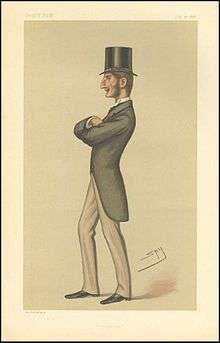Lord Claud Hamilton (1843–1925)
_circa_1916.jpg)

Lord Claud John Hamilton PC (20 February 1843 – 26 January 1925) was a British Member of Parliament (MP) during the Victorian era.
Biography
Born the second son of James Hamilton, 2nd Marquess of Abercorn (later the 1st Duke of Abercorn) and his wife Lady Louisa Jane Russell, Hamilton was educated at Harrow School, and served in the Grenadier Guards and the Royal Inniskilling Fusiliers.[1] In 1865, he became Conservative MP for Londonderry City until 1868 when he was appointed a Lord of the Treasury in Benjamin Disraeli's first ministry. In 1869, he became MP for King's Lynn until 1880,[2] for Liverpool from 1880 to 1885, for Liverpool West Derby from 1885 until he resigned his seat in 1888[3] and for Kensington South from January 1910 to 1918.[3]
Hamilton married Carolina Chandos-Pole (19 July 1857–—21 September 1911) (a granddaughter of the 5th Earl of Harrington) on 20 July 1878 and they had two children:
- Gilbert Claud Hamilton (1879––1943), who gained the rank of Colonel in service of the Grenadier Guards, fought in the Second Boer War and was decorated several times. He married twice, firstly in 1911 Enid Awa Elgar (died 1916), daughter of Charles Elgar from Fernside, Featherston, New Zealand, and secondly in 1916 Mary Blair (died 1961), daughter of Joseph Allan Blair from New York City, USA He had no issue.
- Ida Hamilton (1883––1970), who in 1909 married Hugh Dunombe Flower (died 1950). They divorced in 1923 and had one son.
Lord Claud had been an aide-de-camp to Queen Victoria from 1887 to 1897 and was appointed to the Privy Council in 1917. He died in 1925, aged 81.
However his principal contribution to British public life was as a director of the Great Eastern Railway from 1872, becoming vice-chairman in 1874, and chairman in 1893, continuing as chairman until 1922. "He devoted the main energies of his life to the company, constantly travelling over the system, observing its conduct and operation".[1] The shares of the company (which had been bankrupt in 1866) rose from 76, shortly after he became a director, to par in 1896, and the dividend to 6% in 1901.
In 1900, the Great Eastern Railway named the first of its new class of 4-4-0 express passenger locomotives (designed by James Holden and designated GER Classes S46, D56 and H88 ) after its chairman, and the whole class came be known as the "Claud Hamilton" type. [4]
He died on 26 January 1925, and was buried in Richmond Cemetery.[5]
Legacy
A memorial was erected by Ida Flower in 1925 to the memory of her father. It can be found on the south wall of St John's-Hyde Park Church, London, W2.
Ancestry
| Ancestors of Lord Claud Hamilton (1843–1925) | ||||||||||||||||||||||||||||||||||||||||||||||||||||||||||||||||||||||||||||||||||||||||||||||||||||||||||||||||||||||||||||||||||||||||||||||||||||||||||||||||||||||||||||||||||||||||||||||||||||||||||||||||||||||||||||||||||||||||||||||||||||||||||||||||||||||||||||||||||||||||||||||||||||||||||||||||||||||||||||||||||||||||||||||||||||||||||||||||||||||||||||||||||||||||||||||||||||||||||||||||||||||||||||||||||||||||||||||||||||||||||||||||||||||||||||||||||||||||||||||||||||||||||||||||||||||||||||||||||
|---|---|---|---|---|---|---|---|---|---|---|---|---|---|---|---|---|---|---|---|---|---|---|---|---|---|---|---|---|---|---|---|---|---|---|---|---|---|---|---|---|---|---|---|---|---|---|---|---|---|---|---|---|---|---|---|---|---|---|---|---|---|---|---|---|---|---|---|---|---|---|---|---|---|---|---|---|---|---|---|---|---|---|---|---|---|---|---|---|---|---|---|---|---|---|---|---|---|---|---|---|---|---|---|---|---|---|---|---|---|---|---|---|---|---|---|---|---|---|---|---|---|---|---|---|---|---|---|---|---|---|---|---|---|---|---|---|---|---|---|---|---|---|---|---|---|---|---|---|---|---|---|---|---|---|---|---|---|---|---|---|---|---|---|---|---|---|---|---|---|---|---|---|---|---|---|---|---|---|---|---|---|---|---|---|---|---|---|---|---|---|---|---|---|---|---|---|---|---|---|---|---|---|---|---|---|---|---|---|---|---|---|---|---|---|---|---|---|---|---|---|---|---|---|---|---|---|---|---|---|---|---|---|---|---|---|---|---|---|---|---|---|---|---|---|---|---|---|---|---|---|---|---|---|---|---|---|---|---|---|---|---|---|---|---|---|---|---|---|---|---|---|---|---|---|---|---|---|---|---|---|---|---|---|---|---|---|---|---|---|---|---|---|---|---|---|---|---|---|---|---|---|---|---|---|---|---|---|---|---|---|---|---|---|---|---|---|---|---|---|---|---|---|---|---|---|---|---|---|---|---|---|---|---|---|---|---|---|---|---|---|---|---|---|---|---|---|---|---|---|---|---|---|---|---|---|---|---|---|---|---|---|---|---|---|---|---|---|---|---|---|---|---|---|---|---|---|---|---|---|---|---|---|---|---|---|---|---|---|---|---|---|---|---|---|---|---|---|---|---|---|---|---|---|---|---|---|---|---|---|---|---|---|---|---|---|---|---|---|---|---|---|---|---|---|---|---|---|---|---|---|---|---|---|---|---|---|---|---|---|---|---|---|---|---|---|---|---|---|---|---|---|---|---|---|---|---|---|---|---|---|---|---|---|---|---|---|---|---|---|---|---|---|---|---|---|---|---|---|---|---|---|---|---|---|---|---|---|---|---|---|---|---|---|---|---|---|---|---|---|---|---|---|---|---|---|---|---|---|---|---|---|---|---|---|
| ||||||||||||||||||||||||||||||||||||||||||||||||||||||||||||||||||||||||||||||||||||||||||||||||||||||||||||||||||||||||||||||||||||||||||||||||||||||||||||||||||||||||||||||||||||||||||||||||||||||||||||||||||||||||||||||||||||||||||||||||||||||||||||||||||||||||||||||||||||||||||||||||||||||||||||||||||||||||||||||||||||||||||||||||||||||||||||||||||||||||||||||||||||||||||||||||||||||||||||||||||||||||||||||||||||||||||||||||||||||||||||||||||||||||||||||||||||||||||||||||||||||||||||||||||||||||||||||||||
References
- 1 2 Simmons, Jack and Biddle, Gordon (eds.) (1997). The Oxford Companion to British Railway History. Oxford and New York: Oxford University Press. p. 200.
- ↑ Craig, F. W. S. (1989) [1977]. British parliamentary election results 1832–1885 (2nd ed.). Chichester: Parliamentary Research Services. pp. 168, 192. ISBN 0-900178-26-4.
- 1 2 Craig, F. W. S. (1989) [1974]. British parliamentary election results 1885–1918 (2nd ed.). Chichester: Parliamentary Research Services. pp. 28, 145. ISBN 0-900178-27-2.
- ↑ Allan, Cecil J. (1968). The Great Eastern Railway (Third ed.). London: Ian Allen. p. 127.
- ↑ Meller, Hugh; Parsons, Brian (2011). London Cemeteries: An Illustrated Guide and Gazetteer (fifth ed.). Stroud, Gloucestershire: The History Press. pp. 290–294. ISBN 9780752461830.
External links
- Hansard 1803–2005: contributions in Parliament by Lord Claud Hamilton
- Portraits of Lord Claud Hamilton at the National Portrait Gallery, London

| Parliament of the United Kingdom | ||
|---|---|---|
| Preceded by William McCormick |
Member of Parliament for Londonderry City 1865 – 1868 |
Succeeded by Richard Dowse |
| Preceded by Lord Stanley Hon. Robert Bourke |
Member of Parliament for King's Lynn 1869 – 1880 With: Hon. Robert Bourke |
Succeeded by Sir William ffolkes, 3rd Baronet Hon. Robert Bourke |
| Preceded by Viscount Sandon Edward Whitley Lord Ramsay |
Member of Parliament for Liverpool 1880 – 1885 With: Viscount Sandon 1880–1882 Edward Whitley 1880–1885 Samuel Smith 1882–1885 |
Constituency abolished |
| New constituency | Member of Parliament for Liverpool West Derby 1885 – 1888 |
Succeeded by Hon. William Cross |
| Preceded by Earl Percy |
Member of Parliament for Kensington South Jan 1910 – 1918 |
Succeeded by William Davison |
| Party political offices | ||
| Preceded by Lord Randolph Churchill and Sir Michael Hicks Beach, Bt |
Chairman of the National Union of Conservative and Constitutional Associations 1885 |
Succeeded by Ellis Ashmead-Bartlett |